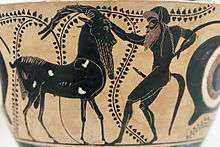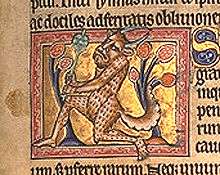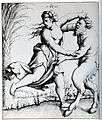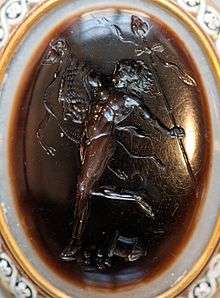Satyr
 | |
| Grouping | Legendary creature |
|---|---|
| Sub grouping | Hybrid |
| Similar creatures | Faun, Minotaur, Centaur, Harpy |
| Mythology | Greek mythology |
| Country | Greece |
| Habitat | Woodland and mountains |
In Greek mythology, a satyr (UK /ˈsætə/, US /ˈseɪtər/;[1] Greek: σάτυρος satyros,[2] pronounced [sátyros]) is one of a troop of ithyphallic male companions of Dionysus with goat-like features and often permanent erection.[3] Early artistic representations sometimes include horse-like legs, but in 6th-century BC black-figure pottery human legs are the most common.[4] In Roman Mythology there is a concept similar to satyrs, with goat-like features: the faun, being half-man, half-goat, who roamed the woods and mountains.[5] In myths they are often associated with pipe-playing. Greek-speaking Romans often used the Greek term saturos when referring to the Latin faunus, and eventually syncretized the two. (The female "Satyresses" were a later invention of poets.)
The satyr's chief was Silenus, a minor deity associated (like Hermes and Priapus) with fertility. These characters can be found in the only complete remaining satyr play, Cyclops, by Euripides, and the fragments of Sophocles' Ichneutae (Tracking Satyrs). The satyr play was a short, lighthearted tailpiece performed after each trilogy of tragedies in Athenian festivals honoring Dionysus. There is not enough evidence to determine whether the satyr play regularly drew on the same myths as those dramatized in the tragedies that preceded. The groundbreaking tragic playwright Aeschylus is said to have been especially loved for his satyr plays, but none of them have survived.
Mature satyrs are often depicted in Roman art with goat's horns, while juveniles are often shown with bony nubs on their foreheads.
As Dionysiac creatures they are lovers of wine and women, and they are ready for every physical pleasure. They roam to the music of pipes (auloi), cymbals, castanets, and bagpipes, and they love to chase maenads or bacchants (with whom they are obsessed, and whom they often pursue), or in later art, dance with the nymphs , and have a special form of dance called sikinnis. Because of their love of wine, they are often represented holding wine cups, and they appear often in the decorations on wine cups.

In Greek mythology and art
.jpg)
Attic painted vases depict mature satyrs as being strongly built with flat noses, large pointed ears, long curly hair, and full beards, with wreaths of vine or ivy circling their balding heads. Satyrs often carry the thyrsus: the rod of Dionysus tipped with a pine cone.

In earlier Greek art, Silenos appear as old and ugly, but in later art, especially in Hellenistic art, he is softened into a more youthful and graceful aspect. This transformation or humanization of the Satyr appears throughout late Greek art. Another example of this shift occurs in the portrayal of Medusa and in that of the Amazon, characters who are traditionally depicted as barbaric and uncivilized. A humanized Satyr is depicted in a work of Praxiteles known as the "Resting Satyr".
Praxiteles gives a new direction to the satyr in art. Instead of an elf with pointed ears and goat hooves, we see a child of nature, pure, tame and fearless, but with the brutal instincts necessary to enable it to defend itself against threats, and surviving even without the help of modern civilization. Above all, the Satyr with flute shows the deep connection with nature, the soft whistle of the wind, the sound of gurgling water, of the crystal spring, the birds singing, or perhaps the melody of a human soul that feeds higher feelings.
(Post-classical Greek spirits known as Calicantsars have a noticeable resemblance to the ancient satyrs; they have goats' ears and the feet of donkeys or goats or horses, are covered with hair, and love women and the dance.)
Although not mentioned by Homer, in a fragment of Hesiod's works satyrs are called brothers of the mountain nymphs and Kuretes, strongly connected with the cult of Dionysus. In the Dionysus cult, male followers are known as satyrs and female followers as maenads or bacchants.
In Attica there was a species of drama dealing with the legends of gods and heroes, and the chorus was composed of satyrs and sileni. In the Athenian satyr plays of the 5th century BC, the chorus commented on the action. This "satyric drama" burlesqued the serious events of the mythic past with lewd pantomime and subversive mockery. One complete satyr play from the 5th century survives, the Cyclops of Euripides.
The Satyr and the Traveller, one of Aesop's Fables, features the satyr as the benevolent host for a traveler in the forest in winter. The satyr is bewildered by the man's claim to be able to blow hot and cold with the same breath, first to warm his hands, then to cool his porridge, and turns him out for this inconsistency.
A papyrus bearing a long fragment of a satyr play by Sophocles, given the title 'Tracking Satyrs' (Ichneutae), was found at Oxyrhynchus in Egypt, 1907.
In Roman mythology and art
_-_Foto_G._Dall'Orto.jpg)
Fauns were conflated in the popular and poetic imagination with Latin spirits of woodland and with the rustic Greek god Pan. Roman satyrs were described as goat-like from the haunches to the hooves, and were often pictured with larger horns, even ram's horns. Roman poets often conflated them with the fauns.
Roman satire is a literary form of poetic essay that was a vehicle for biting, subversive social and personal criticism. Though Roman satire is sometimes linked to the Greek satyr plays, satire's only connection to the satyric drama is the subversive nature of the satyrs themselves, as the Latin word has a completely unconnected etymology, meaning in effect a mixture or miscellany.
In Renaissance art: "Satyrs and fauns (between whom no clear distinction was usually made) were a sort of servant class, and could take on varying mixtures of human or goatish qualities as required".[6]
Other references
In many versions of the Bible, two verses from Isaiah (13:21 and 34:14) use the English word "satyr" as a translation for the Hebrew word "sa'iyr".
Other modern translations of this word from these two verses are goat demons and field-devils. "Sa'iyr" comes from the root word "sa'ar" which means to shiver, or be horribly afraid.
In Leviticus 17:7 there is an allusion to the practice of sacrificing to the se'irim (KJV "devils"; ASV "he-goats"). These may correspond to the "shaggy demon of the mountain-pass" (azabb al-‘akaba) of old Arab legend.[7] It may otherwise refer to literal goats, and the worship of such.[8]
The savant Sir William Jones often refers to the Indian mythological Vānaras as satyrs/mountaineers in his translations of Sanskrit works. This view is generally held to be a mistake by present day researchers.
Baby satyr
Baby satyrs, or child satyrs, are mythological creatures related to the satyr. They appear in popular folklore, classical artworks, film, and in various forms of local art.
Some renaissance works depict young satyrs being tended to by older, sober satyrs, while there are also some representations of child satyrs taking part in Bacchanalian / Dionysian rituals (including drinking alcohol, playing musical instruments, and dancing).
The presence of a baby or child satyr in a classical work, such as on a Greek vase, was mainly an aesthetic choice on the part of the artist. However, the role of a child in Greek art might imply a further meaning for baby satyrs: Eros, the son of Aphrodite, is consistently represented as a child or baby, and Bacchus, the divine sponsor of satyrs, is seen in numerous works as a baby, often in the company of the satyrs. A prominent instance of a baby satyr outside ancient Greece is Albrecht Dürer's 1505 engraving, "Musical Satyr and Nymph with Baby (Satyr's Family)". There is also a Victorian period napkin ring depicting a baby satyr next to a barrel, which further represents the perception of baby satyrs as partaking in the Bacchanalian festivities.[9]
There are also many works of art of the rococo period depicting child or baby satyrs in Bacchanalian celebrations. Some works depict female satyrs with their children; others describe the child satyrs as playing an active role in the events, including one instance of a painting by Jean Raoux (1677–1735). "Mlle Prévost as a Bacchante" depicts a child satyr playing a tambourine while Mlle Prévost, a dancer at the Opéra, is dancing as part of the Bacchanal festivities.[10]
Satyrs and orangutan
In the 17th century, the satyr legend came to be associated with stories of the orangutan, a great ape now found only in Sumatra and Borneo. Many early accounts which apparently refer to this animal describe the males as being sexually aggressive towards human women and towards females of its own species. The first scientific name given to this ape was Simia satyrus.[11]
Varieties
_(3470740119).jpg)
- Island Satyrs, which according to Pausanias[12] were a savage race of red-haired, satyr-like creatures from an isolated island chain.
- Libyan Satyr, which according to Pliny the Elder[13] lived in Libya and resembled humans with long, pointed ears and horse tails, similar to the Greek nature-spirit satyrs.
Medieval bestiaries also mention several varieties of satyrs, sometimes comparing them to apes or monkeys.[14]
Contemporary representations
Satyrs appear in The Chronicles of Narnia: The Lion, the Witch and the Wardrobe, The Chronicles of Narnia: Prince Caspian, The Magician's Nephew, The Lion, the Witch and the Wardrobe, The Horse and His Boy, Prince Caspian, The Silver Chair, and The Last Battle. In the film, The Talented Mr Ripley, Dickie Greenleaf played by Jude Law was inspired by a Satyr figure.
A Satyr appears as a musician for Xerxes in 300 (film)
A small Satyr appears in the Gravity Falls episode "The Last Mabelcorn"
Satyrs appear in Fantasia (1940 film) during the Rite of Spring
The satyr has appeared in all five editions of the Dungeons & Dragons role-playing game, having been introduced in 1976 in the earliest edition, in Supplement IV: Gods, Demi-gods & Heroes (1976),[15] then the first edition Monster Manual (1977),[16] where it is described as a sylvan woodland inhabitant primarily interested in sport such as frolicking, piping, and chasing wood nymphs. The life history of satyr was further detailed in Dragon #155 (March 1990), in "The Ecology of the Satyr."[17] The satyr was later detailed as a playable character race in The Complete Book of Humanoids (1993),[18] and is later presented as a playable character race again in Player's Option: Skills & Powers (1995).[19] The satyr appears in the Monster Manual for the 3.0 edition.[20] Savage Species (2003) presented the satyr as both a race and a playable class.[21] The satyr appears in the revised Monster Manual for 3.5. The satyr appears in the Monster Manual for 4th edition,[22] and as a playable character race in the Heroes of the Feywild sourcebook (2011).[23]
Gallery
- Bronze satyr (height 0.35m) from the Mahdia shipwreck (Musée National du Bardo, Tunis)
 A bald, bearded, horse-tailed satyr balances a winecup on his penis, on an Attic red-figured psykter, c. 500–490 BC
A bald, bearded, horse-tailed satyr balances a winecup on his penis, on an Attic red-figured psykter, c. 500–490 BC Medieval depiction of a Satyr (Satyrs) from the Aberdeen Bestiary.
Medieval depiction of a Satyr (Satyrs) from the Aberdeen Bestiary._02.jpg) Satyr in a state of erection. Detail of a krater, Ancient Greece. 560-550 B.C.
Satyr in a state of erection. Detail of a krater, Ancient Greece. 560-550 B.C. Fight between Satyr and a woman, A sketch of Augustin Hirschvogel.
Fight between Satyr and a woman, A sketch of Augustin Hirschvogel.- Fight between Satyr and a nymph, Naples National Archaeological Museum.
 Satyr's public sex with a nymph. A sketch of Agostino Carracci.
Satyr's public sex with a nymph. A sketch of Agostino Carracci. Satyr dancing the dance such as samba in a hand with a grape (from left to right; Faunus, Bacchus and a satyr), 2nd century A.D.
Satyr dancing the dance such as samba in a hand with a grape (from left to right; Faunus, Bacchus and a satyr), 2nd century A.D. Statue of Satyr Silenius at Athens Archaeological Museum
Statue of Satyr Silenius at Athens Archaeological Museum
See also
- Centaur, half man, half horse (Greek mythology)
- Faun, (Roman mythology)
- Fairy
- Glaistig, (Scottish folklore)
- Jinn
- Leszi, (Slavic mythology)
- List of satyrs in popular culture
- Pan, (Greek mythology)
- Sileni, (Greek mythology)
- The Birth of Tragedy, by Nietzsche
- Thiasos, the Dionysian retinue
- Torgo, a character in Manos: The Hands of Fate
- Urisk, goat-man fairy (Scottish folklore)
- The Trackers of Oxyrhynchus, a play
Notes
- ↑ Wells, John C. (2009). "satyr". Longman Pronunciation Dictionary. London: Pearson Longman. ISBN 978-1-4058-8118-0.
- ↑ Of uncertain etymology; R. S. P. Beekes has suggested a Pre-Greek origin (Etymological Dictionary of Greek, Brill, 2009, pp. 1311–1312).
- ↑ Satyr. Dictionary of Greek Mythology by Hellenica. Retrieved 2015-08-03.
- ↑ Timothy Gantz (1996), Early Greek Myth, p. 135.
- ↑ Branham (1997) p. xxiii
- ↑ Bull, 242
- ↑ "Satyrs," Encyclopaedia Britannica, 11th ed. (1911), vol. 24, p. 234.
- ↑ Palestine Exploration Quarterly, London, 1959, p. 57
- ↑ Revivals, Reveries, and Reconstructions: Images of Antiquity in Prints from 1500 to 1800, Philamuseum.org, exhibition at the Philadelphia Museum of Art.
- ↑ UNH.edu
- ↑ C. W. Stiles. 1926. The zoological names Simia, S. satyrus, and Pithecus, and their possible suppression. Nature 118, 49-49.
- ↑ "Island Satyrs". Theoi Greek Mythology. Retrieved 2008-12-28.
- ↑ "Libyan Aegipans & Satyrs". Theoi Greek Mythology. Retrieved 2008-12-28.
- ↑ Debra Hassing, "Sex in the Bestiaries," in The Mark of the Beast:The Medieval Bestiary in Art, Life, and Literature (New York: Garland Publishing, 1999), p. 73 and 88 (note 16); Willene B. Clark, A Medieval Book of Beasts. The Second-Family Bestiary: Commentary, Art, Text and Translation (Boydell Press, 2006), pp. 133–132.
- ↑ Kuntz, Robert J. and James Ward. Gods, Demi-gods & Heroes (TSR, 1976)
- ↑ Gygax, Gary. Monster Manual (TSR, 1977)
- ↑ Menzies, Gordon R. "The Ecology of the Satyr." Dragon #155 (TSR, 1990)
- ↑ Slavicsek, Bill. The Complete Book of Humanoids (TSR, 1993)
- ↑ Niles, Douglas and Dale Donovan. Player's Option: Skills & Powers (TSR, 1995)
- ↑ Cook, Monte, Jonathan Tweet, and Skip Williams. Monster Manual (Wizards of the Coast, 2000)
- ↑ Eckelberry, David, Rich Redman, and Jennifer Clarke Wilkes. Savage Species (Wizards of the Coast, 2003)
- ↑ Mearls, Mike, Stephen Schubert, and James Wyatt. Monster Manual (Wizards of the Coast, 2008)
- ↑ Carroll, Bart. "The Satyr". Dungeons and Dragons official homepage. Wizards of the Coast. Retrieved 19 February 2012.
References
- Harry Thurston Peck Harpers Dictionary of Classical Antiquities, 1898: "Faunus", "Pan", and "Silenus".
- Branham, R Bracht and Kinney, Daniel (1997) Introduction to Petronius' Satyrica pp.xiii-xxvi
External links
| Wikimedia Commons has media related to Satyrs. |
| Look up satyr in Wiktionary, the free dictionary. |
- Theoi Project: Satyroi
- Satyrs in Cryptozoology
- Jewish Encyclopedia: Satyr
-
 "Satyrs". The New Student's Reference Work. 1914.
"Satyrs". The New Student's Reference Work. 1914.

